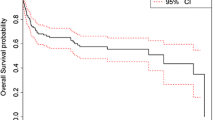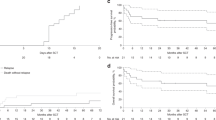Abstract
Background
Post-transplant lymphoproliferative disease (PTLD) is a serious complication of both solid organ and haematopoietic stem cell transplantation in children. Its incidence has increased over the last decade as a result of more potent immunosuppressive regimens. Many treatments have been explored however optimal therapy remains controversial.
Aims
We report on the diagnosis, treatment and outcome of ten patients who were diagnosed with PTLD in Our Lady’s Hospital for Sick Children in Dublin between 2004 and 2015 inclusive.
Methods
Data were collected by retrospective review of patient medical records.
Results
9 out of ten of our patients are alive and disease free following treatment for PTLD with rituximab alone or in combination with chemotherapy.
Conclusion
The outcome of paediatric patients treated for PTLD at our institution is at least comparable to published international series and supports the use of rituximab ± low dose chemotherapy in the treatment of this malignancy.

Similar content being viewed by others

References
Mucha K, Foroncewicz B, Ziarkiewicz-Wroblewska B et al (2010) Post-transplant lymphoproliferative disorder in view of the new WHO classification: a more rational approach to a protean disease? Nephrol Dial Transplant 25:2089–2098
Swerdlow SH, Stein H, Thiele J et al (2008) WHO classification of tumours of haematopoietic and lymphoid tissues. International Agency for Research on Cancer, Lyon
Carbone A, Gloghini A, Dotti G et al (2008) EBV-associated lymphoproliferative disorders: classification and treatment. Oncologist 13:577–585
Dierickx D, Tousseyn T, Sagaert X et al (2013) Single centre analysis of biopsy confirmed post-transplant lymphoproliferative disorder: incidence, clinicopathological characteristics and prognostic factors. Leuk Lymphoma 54:2433–2440
Hoshida Y, Li T, Dong Z et al (2001) Lymphoproliferative disorders in renal transplant patients in Japan. Int J Cancer 91:869–875
Mañez R, Breinig M, Linden P et al (1997) Post-transplant lymphoproliferative disease in primary Epstein–Barr virus infection after liver transplantation: the role of cytomegalovirus disease. J Infect Dis 176:1462–1467
Opelz G, Daniel V, Naujokat C et al (2009) Epidemiology of pretransplant EBV and CMV serostatus in relation to posttransplant non-hodgkin lymphoma. Transplantation 88:962–967
Dharnidharka V, Tejani A, Ho P et al (2002) Post-transplant lymphoproliferative disorder in the United states: young Caucasian males are at highest risk. Am J Transplant 2:993–998
Mynarek M, Schober T, Behrends U et al (2013) Post-transplant lymphoproliferative disease after pediatric solid organ transplantation. Clin Dev Immunol 2013:1–14 (Art ID 814973)
Tsao K, His ED (2007) The clinicopathologic spectrum op post-transplantation lymphoproliferative disorders. Arch Pathol Lab Med 131(8):1209–1218
Gross T, Bucuvalas J, Park J et al (2005) Low dose chemotherapy for Ebstein-Barr virus-positive post-transplant lymphoproliferative disease in children after solid organ transplantation. J Clin Oncol 23(27):6481–6488
Gross T, Orjuela M, Perkins S et al (2012) Low-dose chemotherapy and rituximab for post-transplant lymphoproliferative disease (PTLD): a Children’s Oncology Group report. Am J Transplant 12:3069–3075
Gross TG, Savoldo B, Punnett A (2010) Post-transplant lymphoproliferative diseases. Pediatr Clin N Am 57:881–1503
Swinnen LJ, Leblanc M, Grogan TM et al (2008) Prospective study of sequential reduction of immunosuppression, interferon alpha-2B, and chemotherapy for posttransplantation lymphoproliferative disorder. Transplantation 86(2):215–222
Tsai DE, Hardy CL, Tomaszewski JE et al (2001) “Reduction in immunosuppression as initial therapy for post-transplant lymphoproliferative disorder: analysis of prognostic variables and long-term follow-up of 42 adult patients. Transplantation 71(8):1076–1088
Allen U, Herbert D, Moore D et al (2001) Ebstein-Barr virus-related post-transplant lymphoproliferative disease in solid organ transplant recipients: a Canadian multi centre experience. Pediatr Transplant 5930:198–203
Bakker NA, Verschuuren EA, Erasmus ME et al (2007) Ebstein-Barr virus DNA load monitoring late after lung transplantation: a surrogate marker of the degree of immune suppression and a safe guide to reduce immunosuppression. Transplantation 83(4):433–438
Stuhimann-Laeisz C, Oschiles I, Klappor W et al (2014) Detection of EBV in reactive and neoplastic lymphoproliferations in adults—when and how? J Hematopathol 7(4):165–170
Milpied N, Vasseur B, Parquet N et al (2000) Humanised anti CD20 monoclonal antibody in posttransplant B lymphoproliferative disease: a retrospective analysis of 32 pediatric patients. Ann Oncol 11(1):3–6
Miles JJ, Silins SL, Burrows SR et al (2010) The interplay between EBV and the immune system: a rationale for adoptive cell therapy. Haematologica 95(10):1769–1777
Montanari F, Radeski D, Seshan V et al (2015) Recursive partitioning analysis of prognostic factors in post-transplant lymphoproliferative disorders: a 120 case single institution series. Br J Haematol 171:491–500
Author information
Authors and Affiliations
Corresponding author
Ethics declarations
No funding received.
Conflict of interest
The authors declare that they have no conflict of interest.
Ethical approval
For this type of study formal consent is not required.
This article does not contain any studies with human participants or animals performed by any of the authors.
Additional information
A. Malone and G. Kennedy equally contributed to first authorship.
Rights and permissions
About this article
Cite this article
Malone, A., Kennedy, G., Storey, L. et al. Post-transplant lymphoproliferative disorder in paediatric patients: the Irish perspective—a single centre experience. Ir J Med Sci 186, 339–343 (2017). https://doi.org/10.1007/s11845-016-1425-7
Received:
Accepted:
Published:
Issue Date:
DOI: https://doi.org/10.1007/s11845-016-1425-7



